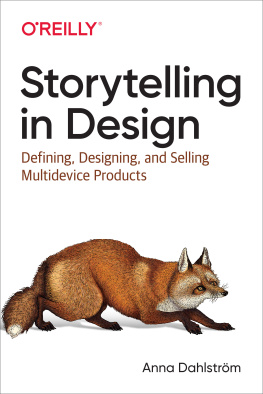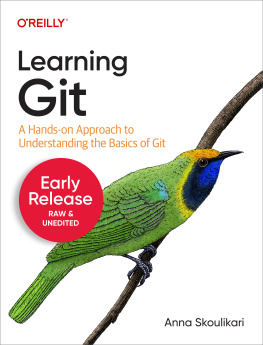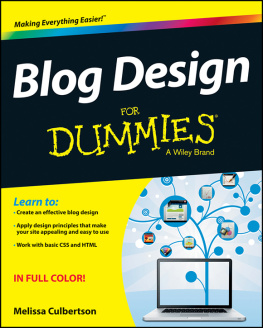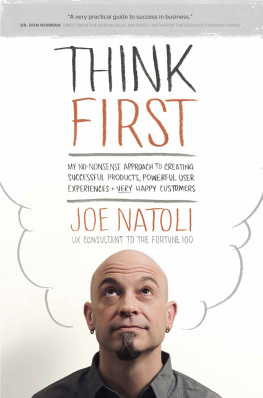Copyright 2020 Anna Dahlstrm. All rights reserved.
Printed in the United States of America.
Published by OReilly Media, Inc., 1005 Gravenstein Highway North, Sebastopol, CA 95472.
OReilly books may be purchased for educational, business, or sales promotional use. Online editions are also available for most titles ( http://oreilly.com ). For more information, contact our corporate/institutional sales department: (800) 998-9938 or corporate@oreilly.com.
See https://www.oreilly.com/catalog/errata.csp?isbn=0636920051374 for release details.
The OReilly logo is a registered trademark of OReilly Media, Inc. Storytelling in Design and related trade dress are trademarks of OReilly Media, Inc.
Many of the designations used by manufacturers and sellers to distinguish their products are claimed as trademarks. Where those designations appear in this book, and OReilly Media, Inc., was aware of a trademark claim, the designations have been printed in caps or initial caps.
Although the publisher and author have used reasonable care in preparing this book, the information it contains is distributed as is and without warranties of any kind. This book is not intended as legal or financial advice, and not all of the recommendations may be suitable for your situation. Professional legal and financial advisors should be consulted, as needed. Neither the publisher nor the author shall be liable for any costs, expenses, or damages resulting from use of or reliance on the information contained in this book.
[ Preface ]
It All Starts with Once upon a time
I grew up in a family where stories were always told . My dad, Ingvar, is a writer, and reading and writing played a big part in my childhood. I remember sitting next to my dad on the sofa with one of my brothers on the other side. Dad would read us the Moomin books, The Chronicles of Narnia, the Brothers Grimm, Hans Christian Andersen, and Astrid Lindgren, and wed sit there completely absorbed.
The stories he read sent us on journeys to places we didnt know existed. They created worlds in our minds and sparked our imaginations by making us see things wed never seen before. As with a dream you dont want to wake up from, we never wanted those reading sessions to stop. We wanted to know what would happen next, how it all began, and how it was going to end. Evening after evening, wed get one step closer until the final page was turned and it was time to start a new chapter, sometimes in a new book.
Many of the classic fairy tales from our childhoods, like Snow White, Rumpelstiltskin, and Hansel and Gretel, start with one of the most widely known sentences in the world: Once upon a time According to The Oxford English Dictionary, the phrase has been used in one form or another since at least 1380 to introduce narratives of past events, typically in the form of fairy tales and folktales. During the 1600 s, it became commonly used as a way to begin oral narratives and often ended with ...and they all lived happily ever after.
Today a number of modern variants of Once upon a time have been introduced, primarily through film and TV. One of the most famous ones is A long time ago, in a galaxy far, far away, which opens the Star Wars films. Other well-known variations are In a land of myth, and a time of magic, which is the opening line of the TV series Merlin, and In the time before time from the movie Bionicle. Whether its the classic Once upon a time or one of the modern variants, these opening phrases signal that its time to sit back because in one form or another, a story will follow. This book is the story of the role that storytelling plays in product design: telling stories with our work is essential for the people and contexts we now design for.
The Art of Storytelling
The art of storytelling has always been a well-respected skill, and those who were great at telling stories were often key figures in their communities. Great storytellers have always been particularly gifted at communicating in a memorable and effective way to not only convey a sequence of events, but also evoke emotions from the listeners. This was key for ensuring that whatever the tale was aboutbe it war, deeds, or eventswasnt forgotten and could be passed on. Today technology and print have solved the challenge of how to pass on information, but great storytellers remain key figures just as much now as in the old days.
In 2014 , Raconteur published an article and infographic called The Worlds Greatest Storytellers. It was the result of a survey that asked almost five hundred authors, journalists, editors, students, and media and marketing professionals who they considered to be great storytellers. The top five included William Shakespeare, J.K. Rowling, Roald Dahl, Charles Dickens, and Stephen King, but there was great diversity in the responses and the reasons behind their respective choices. The suggestions spanned continents, genres, disciplines, and mediums. Some picked influential people in their own fields. Others chose family members whod influenced their love for writing and history. Yet others based their choice on their own definition of great. What united them all was that, in one way or another, their stories had hit home.
This points to some of the key aspects of a good story. However we tell or create a story, all good stories capture the audiences attention and resonate with them. At times theyre almost spellbinding and draw us in so deep that we cant help but keep on turning pages to find out what happens next. Other times a gripping tale of faith connects with us emotionally and moves us to excitement, or even rageThis cant be right, How could they let that happen? All instances of good storytelling involve a bit of magic. The narrator draws the audience into the world theyre telling a story about and, to some extent, holds them captive by building up the anticipation around how the story will end.
Why I Wrote This Book
While many stories in the form of film, TV series, plays, novels, and books tend to come with happy endings, storytelling is increasingly moving outside its traditional form. A quick search on Google for storytelling and business returns around million results, and there is no doubt that storytelling has become a buzzword in the business world over the last few years. However, as this book covers, its not without good reason. Stories have the power to make us see things, to move us emotionally as well as into action, and to make us process and remember facts. Responding to and telling stories is part of what makes us human.












